Chinese Beverages
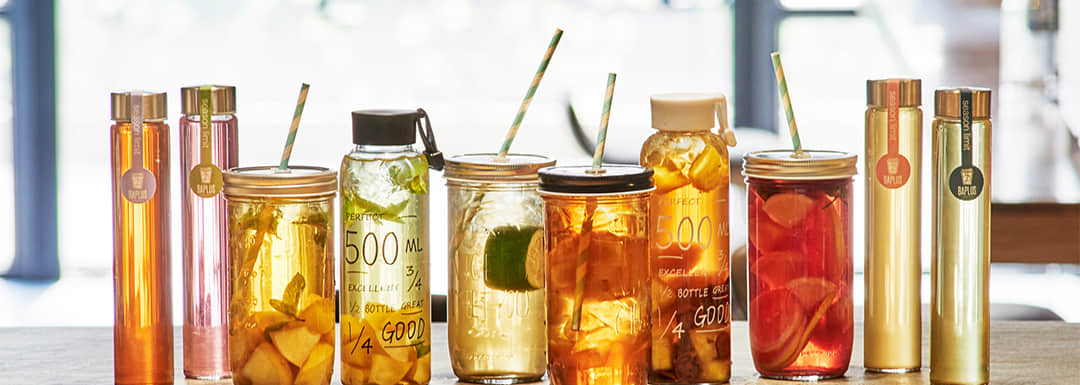
Not surprisingly, just as Chinese food is interesting and complicated, so are Chinese drinks. There are several ubiquitous drinks, and then there is a wide range of other possibilities.
1. Water

Drinking water is considered health care
Chinese people generally drink hot water, rather than cold, and you will often see people carrying around a thermos or jar of hot water. It’s not uncommon in many premises to see a water dispenser with two options, one for hot water, and one for lukewarm water – because nobody wants to drink cold water. Drinking hot water is better for your health, aids digestion, and helps to ward off sickness.
You may be interested in Hot Water in China.
2. Teas

Chinese Tea
As well as hot water, pretty much everyone drinks tea, and there is an endless variety of teas (and tisanes, or herbal teas) available to drink. Teahouses are great places to sample something new, with lots of possible health benefits. In almost any social situation, at least green tea will be offered – while someone stands by to constantly top up your cup as you drink. And then there are also the more complex tea ceremonies. Some other popular teas to try are black tea, Chrysanthemum tea, Oolong tea, or Jasmin tea. Then there is Wang Lao Ji, or Jia Duo Bao, two brands of the same herbal tea that tastes of mint and honey and has a soothing effect.
Read more about Chinese Tea.
3. Pearl Milk Tea
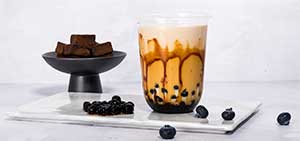
Pearl Milk Tea is a popular drink for young
This drink is particularly popular among the young people. Sometimes called “bubble tea”, and containing jelly-like beads made of tapioca sitting in the bottom of sweetened milk tea, it comes in a variety of colors and fruit flavors, and can be served hot or cold, usually with a thick plastic straw supplied through which the pearls can be sucked up and chewed.
4. Herbal Teas

Suanmeitang is a great match for hot pot
Herbal teas, herbal infusions, or ‘tisanes’ are all terms for beverages made from the infusion of herbs, spices, or other plant material in hot water. The result may appear dark brown in color and can sometimes have a bitter taste. People in parts of Southern China, such as Guangdong, Hong Kong, and the Macao area like to drink this beverage if they are suffering from a dry throat and a strong thirst. Herbal teas from the Guangdong area are the most traditional Chinese herbal infusions. Of course, ‘herbal teas’ are not really ‘tea’ at all, as they do not contain leaves from camellia sinensis, the tea plant. According to the indigenous climate and environment, these beverages are comprised of a compound of local herbs, or brewed from a single herb. In the past, as progress was made in the area of disease prevention and health care, herbal beverages were developed along with traditional Chinese medicine to help with a fever, sweating, or dehydration. For people who can’t handle the bitter taste, Plum Soup (suān méi tāng酸梅汤 ), or Sugar Cane Tea (gān zhè shuǐ甘蔗水) would be worth a try.
Suanmeitang (酸梅汤sour plum drink)
This cooling and soothing drink is a great match for hot pot and spicy Chinese dishes. The sweet-sour taste helps ease a burning tongue and stomach. It is made of sour plums, hawthorn, liquorice root, rock salt and sweet Osmanthus.
5. Baijiu
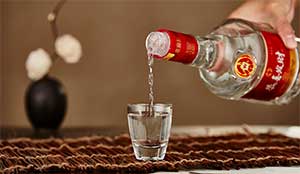
Baijiu
Cheap and easy to obtain (even from convenience stores), and flowing freely at banquets and social occasions, this drink is often used in drinking games, toasting and special ceremonies of well-wishing. Although usually served in small glasses, having an alcohol content anywhere from 35 to 60 %, it can quickly lead to a sense of bewilderment and stupor. With a bouquet similar to nail varnish remover, it is a distilled spirit, usually made from sorghum or other grain. And unlike other Chinese beverages, it is not a health choice.
Keep reading for the in-depth detail on Baijiu (Chinese Alcohol) and Ganbei (Bottoms up) - Chinese Drinking Culture
6. Red Wine
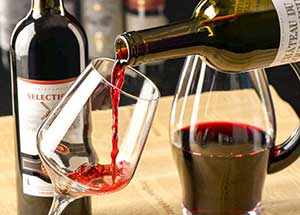
Red Wine
Wine making was introduced to China from Europe after the Western Han Dynasty. China’s indigenous vine species have been cultivated and used to make wine for more than 1500 years. Currently, China’s wine region is spread right across the breadth of the country, mainly in the Shandong Peninsula (including Yantai Province), Hebei Province, the regions ofNingxia and Shanxi, and Yunnan plateau in the southwest of the country. These areas have become known for their high quality wines.
In China, wine made from grapes is referred to as hongjiu, or ‘red alcohol’. Although white wine (not to be confused with baijiu, the popular clear/white alcoholic drink made from grain) is also available in China, the red is more popular and becoming increasingly so. It sells for a better price, and is more easily stored, and the color red is considered lucky. Hence ‘red wine’ can refer to all grape based wines.
7. Beer

Beer
There are a number of beers, which are cheap, popular and refreshing. The most recognized Chinese beer in the world, Tsingtao is sold in 62 countries. A lager with a high malt flavor and a hint of hops, Tsingtao is easy to drink and doesn't leave a bitter aftertaste. Produced in the seaside city of Qingdao, the German-style beer uses spring water from Laoshan in Shandong province, a mountain area known for its water purity. The company imports its hops, yeast and barley from Australia and Canada. Another example is Sinkiang Black Beer, or Xinjiang Black Beer, which is a nut-scented, strong flavored ale, with a hint of brown-sugar like sweetness, similar to an American dark lager.
8. Soybean Milk (dòu jiāng豆浆) and Soy Milk (dòu nǎi豆奶)

Soy Milk
Both ‘Soybean Milk’ and ’Soy Milk’ are clearly soy-based drinks, so what is the difference between the two? The difference lies in the processing technology.
‘Soy Milk’ is made in the traditional way, which involves soaking the soybeans to soften them, grinding them, straining out the residue, and finally boiling the liquid. The ‘milk’ tastes a bit grainy and has a beany flavor, as a result of this processing method. This drink can even be made at home with a milk machine.
The processing method for ‘Soybean Milk’, on the other hand, involves crushing the soybeans, extracting the water-soluble ingredients, and then filtering out any impurities. After that, it is heated to ultra-high temperatures, deodorized, homogenized under high pressure, and finally cooled and sterilized to make a milky and exquisitely textured liquid. Of course, pure soy milk doesn’t actually contain any real milk. However, some soy milk beverages sold in supermarkets may actually add real milk to improve nutrition and texture. People who are allergic to milk need to check the formula or ask a salesman to confirm the ingredients, or just avoid drinking soy milk while in China.
9. Coconut milk
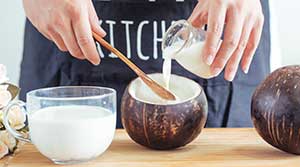
Coconut milk
China's canned coconut milk is made from the meat of the fruit. Milk, water and sugar give it a thicker consistency than regular coconut water.
10. Osmanthus wine

Osmanthus wine
This delicious after-dinner drink is similar to French liqueur and can be served chilled or warm. It is described as very sweet, while having the special scent of the flower itself.
11. Wahaha Nutri-Express

Wahaha娃哈哈
Comparable to what liquid Skittles might taste like, this drink is a mix of fruit juice and milk. Its consistency is lighter than yogurt drinks and similar to skim milk -- a little watery. It is a healthy alternative to the milkshake, and is one of China's top selling bottled drinks.
12. Coffee
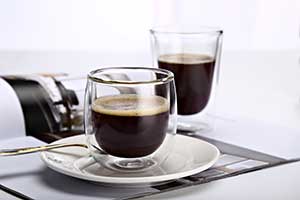
Coffee
Chinese people drink considerably less coffee than people in western countries, although nowadays the demand is rising for both coffee flavored drinks and fresh coffee. The coffee bean in China originated in the areas of Yunnan, Hainan, and Taiwan Province. This is especially true of Yunnan with its abundant sunshine, plentiful rainfall and large variations in temperature. All of these great natural conditions come together to produce Yunnan Arabic Coffee which features a delicious aroma, rich and fruity, but without a bitter taste.
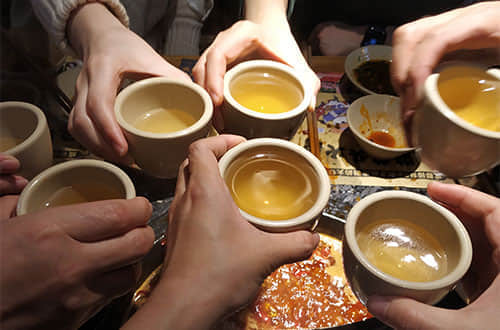 Ganbei (Bottoms up) - Chinese Drinking Culture
Ganbei (Bottoms up) - Chinese Drinking Culture  Drinking Water in China
Drinking Water in China 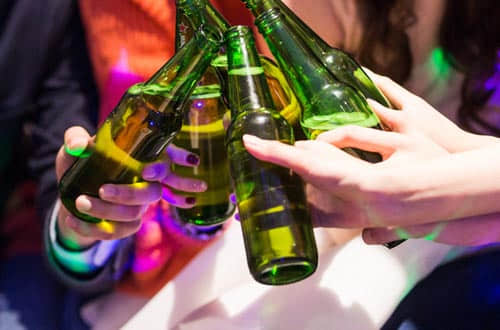 Baijiu Drinking Etiquette
Baijiu Drinking Etiquette 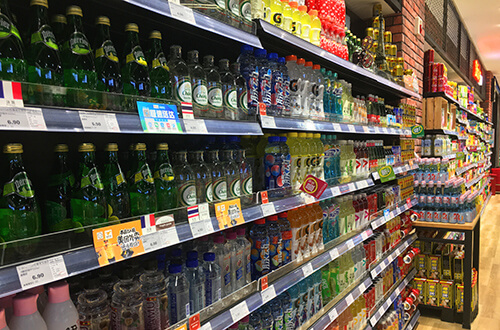 Eating & Drinking Food Cost
Eating & Drinking Food Cost